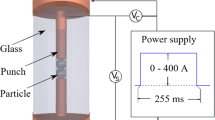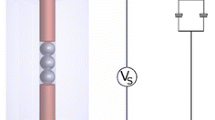Abstract
Experiments with aluminum, copper, and silicon powders are performed to study the mechanism of shock-wave magnetic cumulation. For all substances examined, the magnetic field as a function of the cavity area is described by a power dependence with a constant exponent α. The value of α depends substantially on the substance porosity and particle size. For copper and silicon powders and for small-size aluminum powder, the value of α is consistent with the ratio of the particle velocity u to the wave velocity D, as is predicted by a simple model of magnetic cumulation. For the fine and coarse aluminum powders, the value of α is noticeably smaller than the ratio u/D. The lower effectiveness of magnetic compression can be attributed to insufficiently high electrical conductivity (fine powder) and the emergence of conductivity with incomplete compression of the substance (coarse powder). In the first case, diffusion losses of the magnetic flux in the compressed substance are fairly noticeable. In the second case, the work against the magnetic forces is performed by a layer in the shock-transition region, which has a lower particle velocity. The mechanism of magnetic cumulation involves substance metallization under shock compression and expelling of some portion of the magnetic flux to the non-conducting region ahead of the shock front. The two-stage mechanism of cumulation known in the literature (metallization in the elastic precursor and subsequent compression of the field in the main wave) is not validated by experiments with measurements of the particle and wave velocities and electrical conductivity and by experiments on magnetic cumulation.
Similar content being viewed by others
References
E. I. Bichenkov, S. D. Gilev, and A. M. Trubachev, “Magnetic course generators using the transition of a semiconductor material into a conducting state,” J. Appl. Mech. Tech. Phys., 21, No. 5, 678–681 (1980).
S. D. Gilev and A. M. Trubachev, “MC generators operating on powdered aluminum,” in: Dynamics of Continuous Media (collected scientific papers) [in Russian], No. 48, Inst. of Hydrodynamics, Sib. Div., Acad. of Sci. of the USSR, Novosibirsk (1980), pp. 30–32.
K. Nagayama, “New method of magnetic flux compression by means of the propagation of shock-induced metallic transition in semiconductors,” Appl. Phys. Lett., 38, No. 2, 109–110 (1981).
S. D. Gilev and A. M. Trubachev, “Production of strong magnetic fields by shock waves in a medium,” Sov. Tech. Phys. Lett., 8, No. 8, 396–397 (1982).
K. Nagayama, T. Oka, and T. Mashimo, “Experimental study of a new mechanism of magnetic flux cumulation by the propagation of shock-compressed conductive region in silicon,” J. Appl. Phys., 53, No. 4, 3029 (1982).
S. D. Gilev and A. M. Trubachev, “Obtaining strong magnetic fields with magnetocumulating generators based on a porous material,” J. Appl. Mech. Tech. Phys., 24, No. 5, 639–642 (1983).
K. Nagayama and T. Mashimo, “New method of magnetic flux compression by the propagation of shock-compressed conductive region in semiconductors,” in: High Field Magnetism, Proc. Int. Symp. on High Field Magnetism (Osaka, Japan, September 13–14, 1982), North-Holland, Amsterdam (1983), pp. 319–321.
E. I. Bichenkov, S. D. Gilev, and A. M. Trubachev, “Shock-wave MC generators,” in: V. M. Titov and G. A. Shvetsov (eds.), Ultrahigh Magnetic Fields. Physics. Techniques. Applications, Proc. 3rd Int. Conf. on Generation of Megagauss Magnetic Fields and Related Experiments (Novosibirsk, 1983), Nauka, Moscow (1984), pp. 88–93.
K. Nagayama and T. Mashimo, “Magnetohydrodynamic study of flux cumulation by the propagation of shock-compressed conductive region in semiconductors,” ibid., pp. 270–277.
S. D. Gilev and A. M. Trubachev, “Application of shock waves for generation of superstrong magnetic fields,” in: Electromechanical Converters of Energy [in Russian], Naukova Dumka, Kiev (1986), pp. 113–115.
E. I. Bichenkov, S. D. Gilev, A. M. Ryabchun, and A. M. Trubachev, “Shock-wave method of generating megagauss magnetic fields,” J. Appl. Mech. Tech. Phys., 28, No. 3, 331–339 (1987).
E. I. Bichenkov, S. D. Gilev, A. M. Ryiabchun, and A. M. Trubachev, “Shock-wave method for generation of megagauss magnetic fields,” in: C. M. Fowler, R. S. Caird, and D. J. Erickson (eds.), Megagauss Technology and Pulse Power Application: Proc. Fourth Int. Conf. on Megagauss Magnetic Field Generation and Related Topics (Santa Fe, July 14–17, 1986), Plenum Press, New York-London (1987), pp. 89–105.
K. Nagayama and T. Mashimo, “Explosive-driven magnetic flux cumulation by the propagation of shock-compressed conductive region in highly porous metal powders,” J. Appl. Phys., 61, No. 10, 4730–4735 (1987).
K. Nagayama and T. Murakami, “Magnetohydrodynamic study of the interaction of magnetic flux with high-pressure shock waves in metal powder,” in: H. Gronig (ed.), Shock Tubes and Waves, Proc. of the 16th Int. Symp. on Shock Tubes and Shock Waves (Aachen, July 26–31, 1987), Aachen (1988), pp. 881–887.
K. Nagayama, “Shock Wave interaction in solid materials,” in: A. B. Sawaoka (ed.), Shock Waves in Materials Science, Springer-Verlag (1993), pp. 195–224.
A. M. Trubachev, “MC generators. Selection of optimal experimental conditions,” J. Appl. Mech. Tech. Phys., 36, No. 3, 336–340 (1995).
A. M. Trubachev and A. M. Ryabchun, “MC generator with a shock-wave cascade,” J. Appl. Mech. Tech. Phys., 37, No. 4, 470–475 (1996).
E. I. Bichenkov, S. D. Gilev, A. M. Ryabchun, and A. M. Trubachev, “Magnetic-field compression by shock-induced conduction waves in high-porosity materials,” J. Appl. Mech. Tech. Phys., 37, No. 6, 785–793 (1996).
E. I. Bichenkov, S. D. Gilev, A. M. Ryabchun, and A. M. Trubachev, “Shock-wave cumulation of the magnetic field. Ultimate capabilities of the method,” in: V. K. Chernyshev, V. D. Selemir, and L. N. Plyashkevich (eds.), Megagauss and Megaampere Pulsed Technology and Applications, Proc. 7th Int. Conf. on Generation of Megagauss Magnetic Fields and Related Experiments, Vol. 1, Inst. Exp. Phys., Sarov (1997), pp. 121–128.
A. A. Barmin, O. A. Mel’nik, A. B. Prishchepenko, et al., “Losses of electromagnetic energy during compression of the magnetic field by a shock wave of the second kind,” Izv. Ross. Akad. Nauk, Mekh. Zhidk. Gaza, No. 6, 166–170 (1988).
J. Tyl and E. Wlodarczyk, “A new method for isentropic compression of materials,” J. Tech. Phys., 32, No. 2, 187–197 (1991).
A. L. Velikovich, “Ultimate capabilities of the method of magnetic field compression by converging shock waves,” Zh. Tekh. Fiz., 62, No. 6, 47–59 (1992).
A. A. Barmin and A. B. Prishepenko, “Compression of magnetic field in a single crystal by a strong converging ionizing shock wave,” in: M. Cowan and R. B. Spielman (eds.), Megagauss Magnetic Field Generation and Pulsed Power Application, Proc. of the Sixth Int. Conf. on Megagauss Magnetic Field Generation and Related Topics, Nova Sci. Publ., New York (1994), p. 35.
H. Almstrem, G. Bjarnholt, S. M. Golberg, and M. A. Liberman, “Methods of generation of superstrong pulsed magnetic fields,” in: V. K. Chernyshev, V. D. Selemir, and L. N. Plyashkevich (eds.), Megagauss and Megaampere Pulsed Technology and Applications, Proc. 7th Int. Conf. on Generation of Megagauss Magnetic Fields and Related Experiments, Vol. 1, Inst. Exp. Phys., Sarov (1997), pp. 146–153.
H. Almstrem, G. Bjarnholt, S. M. Golberg, and M. A. Liberman, “Numerical simulation of magnetic field compression by a converging cylindrical ionizing shock wave,” ibid., pp. 465–471.
G. Bjarnholt, S. M. Golberg, and S. E. Nyholm, “Compression of the magnetic flux by imploding ionizing shock waves,” in: Proc. Pulse Power Conf. (1997), pp. 1497–1502.
A. A. Barmin and M. S. Rumnenko, “Compression of the magnetic field by a strong ionizing shock wave in a Csl single crystal,” Izv. Ross. Akad. Nauk, Mekh. Zhidk. Gaza, No. 3, 146–158 (2002).
B. M. Novac, I. R. Smith, D. F. Rankin, and M. Hubbard, “An insulator-metallic phase transition cascade for improved electromagnetic flux-compression in θ-pinch geometry,” IEEE Trans. Plasma Sci., 32, No. 5, 1960–1965 (2004).
S. D. Gilev, “Electrical conductivity of metal powders under shock compression,” Combust., Expl., Shock Waves, 41, No. 5, 599–609 (2005).
S. D. Gilev, “Electrode gauge as an instrument for studying shock compression and metallization of the substance,” Combust., Expl., Shock Waves, 43, No. 5, 598–606 (2007).
R. F. Trunin, G. V. Simakov, Yu. I. Sutulov, et al., “Compressibility of porous metals in shock waves,” Zh. Éksp. Teor. Fiz., 96, No. 3(9), 1024–1038 (1989).
A. A. Bakanova, I. P. Dudoladov, and Yu. N. Sutulov, “Shock compressibility of porous tungsten, molybdenum, copper, and aluminum in the low pressure domain,” J. Appl. Mech. Tech. Phys., 15, No. 2, 241–245 (1974).
R. G. McQueen, S. P. Marsh, J. W. Taylor, et al., “The equations of state of solids from shock-wave studies,” in: R. Kinslow (ed.), High Velocity Impact Phenomena, Academic Press, New York (1971).
D. Saumon, “Cumulative processes. Self-similar solutions,” in: P. Caldirola and H. Knoepfel (eds.), Physics of High Energy Density, Academic Press, New York (1971).
B. M. Novac, I. R. Smith, S. E. Goh, M. C. Enache, K. Gregory, P. Senior, and H. R. Stewardson, “A novel flux compression/dynamic transformer technique for high-voltage pulse generation,” IEEE Trans. on Plasma Sci., 28, No. 5, 1356–1361 (2000).
B. M. Novac, I. R. Smith, and S. E. Goh, “Monitoring the velocity of the insulator-metallic phase transition in aluminium powder under shock loading,” J. Phys., D: Appl. Phys., 34, 174–176 (2001).
R. F. Trunin, L. F. Gudarenko, M. V. Zhernokletov, and G. V. Simakov, Experimental Data on Shock-Wave Compression and Adiabatic Expansion of Condensed Substances [in Russian], Inst. Exp. Phys., Russian Federal Nuclear Center, Sarov (2001).
Author information
Authors and Affiliations
Corresponding author
Additional information
__________
Translated from Fizika Goreniya i Vzryva, Vol. 44, No. 2, pp. 106–116, March–April, 2008.
Rights and permissions
About this article
Cite this article
Gilev, S.D. Experimental study of shock-wave magnetic cumulation. Combust Explos Shock Waves 44, 218–227 (2008). https://doi.org/10.1007/s10573-008-0029-6
Received:
Issue Date:
DOI: https://doi.org/10.1007/s10573-008-0029-6




